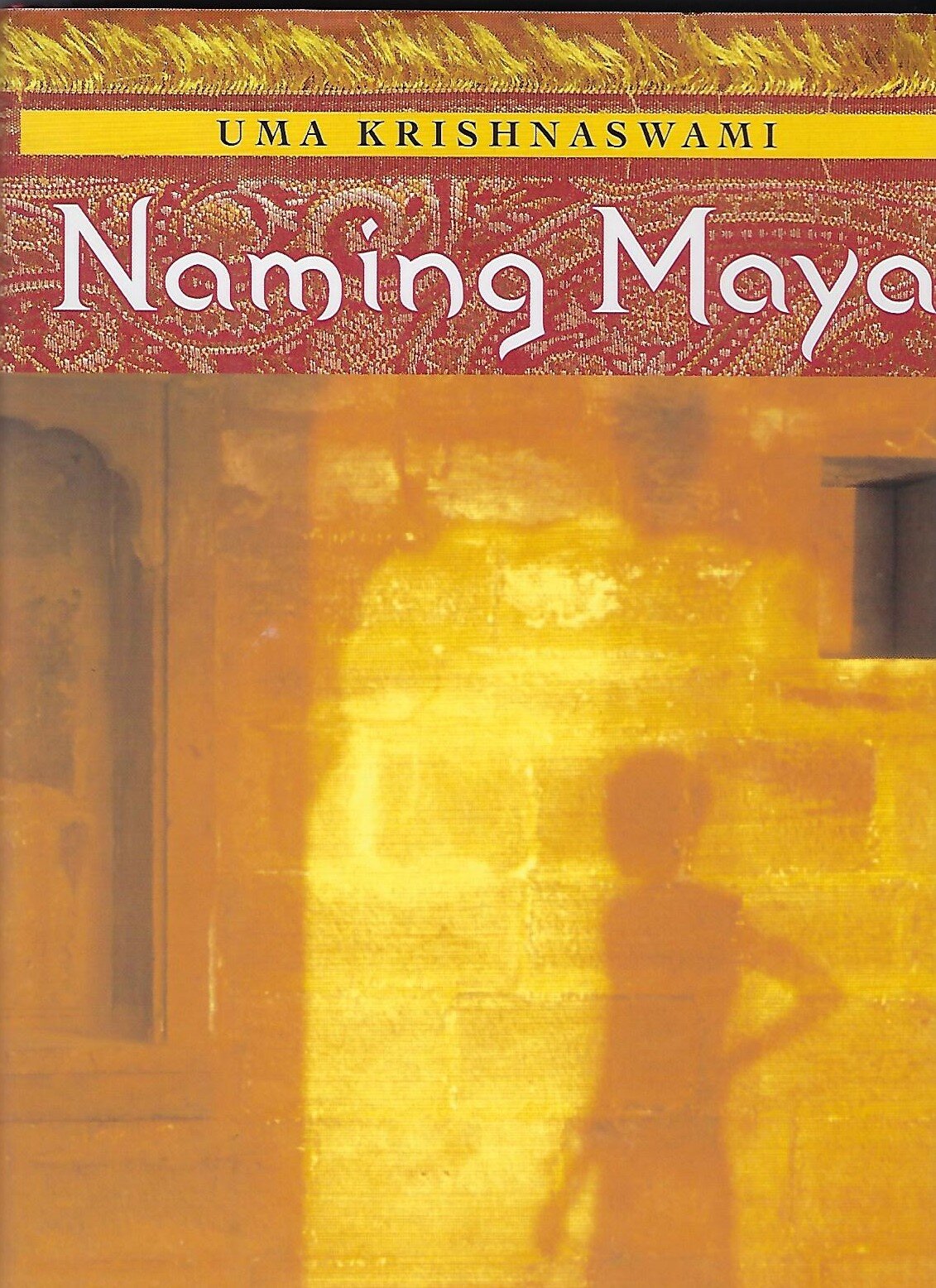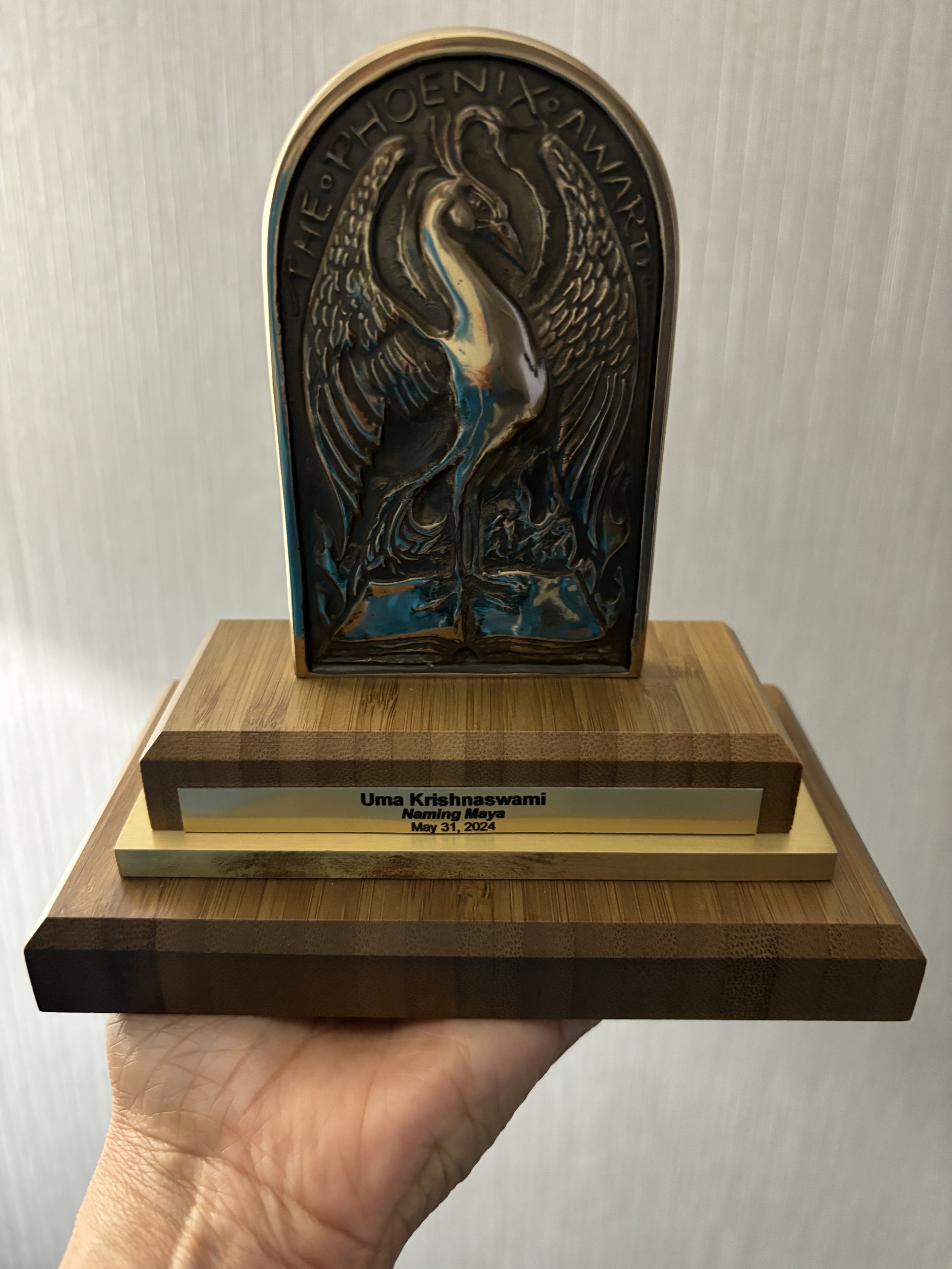Writing for the Long Haul: Remarks for the Phoenix Award Roundtable
2024 brought a nice surprise to my email inbox. My first middle grade novel, Naming Maya, published in 2004, had been selected for the Phoenix Award, a most unusual children’s literature award in the United States. Unlike just about every other award, it’s not given to a newly edited, newly published book. Rather it elevates and honors books that were published 20 years before the year of the award.
Twenty years! That’s a whole generation of readers. Here’s the description from the web site:
The Children's Literature Association Phoenix Award recognizes books of exceptional literary merit. First presented in 1985, it is given to the author, or the estate of the author, of a book for children first published twenty years earlier that did not win a major award at the time of its publication but which, from the perspective of time, is deemed worthy of special attention. Since 1989, honor books have also been named.
As a result of this unexpected affirmation of my first novel, I ended up attending the Children’s Literature Association conference in Madison, WI and received a lovely bronze statue designed by no less distinguished an illustrator than Trina Schart Hyman. Here are my remarks to the Phoenix Award Roundtable at the conference:
In 2008, I was invited by the Japanese American National Museum to a conference in Denver. The conference was titled: Whose America? Who’s American? The first, a possessive, w-h-o-s-e? The second a contraction, who, apostrophe s—who is—American? I was honored to be asked, but I wondered, why me? What could I say that was relevant to the culturally and historically specific mission of that conference? But as the session unfolded, I realized that I was there as an ambassador for stories. I was there because I had written books for young readers that drew on particular histories and on a specific cultural experience. Among them was a novel, Naming Maya.
Building an identity can be a life’s work and this is doubly so for those of us who are immigrants. How do you carry your personal geography with you, your sense of who you are relative to the place that shaped you? When you go to a new place, whatever your reason, how do you create new mental geographies—do you dump the old and start afresh or do you begin to knead your experiences together like dough so that you are literally remaking yourself?
As a child growing up in India, I never thought I would be a writer. No one in my family wrote books. No one I knew wrote books. But mainly, I never saw a character like myself in a book. Many of the books I read were written by English writers and many of those writers happened to be dead, so quite naturally I assumed that you had to be English and dead to be a writer. I wasn’t English and I certainly wasn’t dead so it never crossed my mind that writing was something I could hope to do. It wasn’t until my son was born—he is now married with two little ones of his own—that it occurred to me. Real live people could write children’s books and perhaps this was something I should try doing.
With Naming Maya, I imagined a story that spanned the distance between the United States and India. I was still learning how to take elements of life and weave them into fiction. Every time I left either country, I’d find both the place and myself changed upon my return. How, I wondered, would a child feel, a child of parents who had chosen to migrate as I had? This is why I think that conference title spoke to me—Whose America? Who’s American? I’d grappled with those questions not only about myself, but also about my son, who was around 10 when I began writing this novel.
Travel back with me, if you will, to the 1990’s. I had several half-written manuscripts and nothing published. In my local library in Greenbelt, Maryland, I was finding books on the children’s shelf that made me uneasy—Five Chinese Brothers with its casual stereotyping; less obtrusively, Miss Rumphius, unfolding in the middle to two spreads about world travel that read to me like a 4-page summary of colonialism and imperial looting. Products of their time, sure, but surely, they carried nuances worth reexamining. Contemporary representations of South Asia in American children’s literature were flat-out missing. It was as if we didn’t exist. Well, there was Kipling, The Secret Garden, The Little Princess. You’d think everyone from the subcontinent was long-ago, faraway, possibly villainous, and definitely dead.
So I began looking for children’s books by writers of color and I found Dragonwings by Laurence Yep, winner of the 1995 Phoenix Award. From its first page, it had me in its grip, with its clear, bold perspective and its refusal to compromise on the complexities of generational difference or of overlapping histories, migrants from China on the one hand; on the other, the Wright Brothers. American stories both, equally capable of taking to the air like dreams of a flying machine.
I have a different connection to The Fledgling by Jane Langton—2000 Phoenix honor book. I admired the words and tried to understand the craft. My son, who read it and developed a daredevil relationship with stairs, had to be cautioned not to try flight experiments. He also took to sticking maple seeds onto his nose like rhinoceros horns. He pulled up blades of grass to turn into flutes. We both became transfixed by the sight of Canada geese flying overhead. A book can scatter unexpected feathers into your life.
Some books make you want to read more; other books make you want to write. Like One Bird by Kyoko Mori—2015 winner. I remember feeling the role that time plays in the story, the sense of past and present speaking to one another. I remember the mother saying, “No bad time lasts forever.” I didn’t know when I read it that this book was among those that gave me permission to write about the complicated family dynamics I was exploring in Naming Maya, but that is what it did.
One last Phoenix selection I would like to claim is A Long Way from Verona by Jane Gardam—winner, 1990. Gardam taps the strange spaces inhabited by a fiction writer like no one else. I read this book a few years after Naming Maya came out and it reached most unexpectedly into my youth. When I was 15, I wrote a fan letter to British novelist P.G. Wodehouse—Plum to fans and friends. Some part of me was starving to talk to a writer—about anything but particularly about books and stories and words—well, let’s be honest, my words. Had I been in young Jessica’s place I too would have pursued that visiting writer, Arnold Hanger, to the railway station and thrust my work at him. Like Jessica, I received a reply. It was typed on a typewriter with the o’s and b’s and d’s slightly smudged, complete with an air mail envelope bearing Wodehouse’s wife’s return address label. I have that letter still. In it, Plum wishes me luck in my exams (I must have written about them). He tells me, “I am sure you will do very well.” Strange how words on a page can connect humans, so far beyond geographic or temporal borders.
Publication is a game of chance. It so happened that Naming Maya, which was then a kind of red-hot mess of yearning and character and plotlessness, landed on the editorial desk of Janine O’Malley at Farrar Straus Giroux. I have a feeling that she, too, sensed the red-hot messiness of it although she was far too kind and professional to say so. She told me recently that it was only the second novel she had edited so it was suggested that someone senior should support her. The legendary Frances Foster generously offered to read the manuscript with Janine’s edits and offered some thoughts of her own. Oh, my Maya needed so much help.
I remember a revision that refused to hold together; a scene that I’d ended by having my protagonist leave the room. Janine wrote to me, asking where I was going with that scene. I’d built tension between my character and her mother, but it all felt episodic, not leading anywhere. She wrote, why not try keeping Maya and her mother together in the room and letting them talk? Why not let the scene build instead of cutting it short? All this to say, don’t avoid conflict.
In real life, mind you, I am a champion avoider of conflict. But fiction offers us ways to practice what seems impossible in life. I have since passed this question along to many writers: why not let the scene build? Why not let the story go where it wants to?
My writer colleague and friend Sharon Darrow says when we revise a story, we can’t help also revising ourselves. Every story teaches us to write it, so we learn to be the writer that each new story needs. Reading that note from Janine was one of those revision moments.
Naming Maya was the novel that taught me how to write a novel, but I don’t think I realized then that what I was doing was trying to write past the conventions of that time. My writing group helped by raising questions. We had many animated discussions about my use of Tamil language words, my refusal to employ parenthetical comma phrases to provide parallel translation. I didn’t always know how to articulate the reasons for my choices, but I knew which ones I was willing to fight for. “What does Maya want?” they asked me. “What’s going to stand in the way?” Well, I didn’t know that. She didn’t know. This story wasn’t about what she wanted and what stood in the way. It was another kind of story whose contours I couldn’t yet see. I didn’t know yet how to put it all together.
But I am stubborn, and the story was stubborn too. It wouldn’t leave me alone and somehow, I grew with it and it grew with me. Along the way, I think I persuaded my writer friends to trust that my experimental writing was going to lead somewhere. I didn’t know that of course—you never do, with work in progress. But trusting the work, if not entirely trusting yourself, is an essential component of learning to write.
So much has changed since 2004. Naming Maya was published before Ancestry.com and genetic testing, before social media, before Covid, before global protests over racial inequity, before the climate emergency punched up into overdrive, before migration became a crisis, before AI, before so much that has now come to define our world. So for the Phoenix committee to deem in 2024 that this book has stood the test of time—that’s a gift that makes my heart sing. Thank you.


